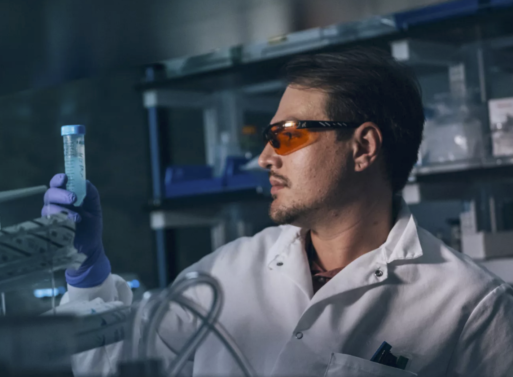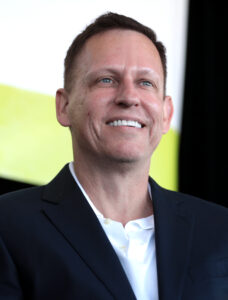
Scientific breakthroughs promise to re-engineer the way we age.
Credit: Mikhail Nilov
Billionaires who’ve been spending millions on longevity research to significantly extend lifespans – even “solve aging” – have been criticized as selfish and potentially foolhardy by some. But their efforts may end up producing just-in-time breakthroughs as humanity draws closer to one of the biggest challenges of the 21st century – an aging worldwide population.
In his new book “The Longevity Imperative,” British economist Andrew J. Scott calls this approaching gray tsunami “an existential challenge as consequential as AI and climate change.” The tipping point will occur in 2035, when for the first time in the United States there will be more people over 60 than under 18. And as it stands now, with healthcare costs ballooning dramatically at the end of life, and more people relying on fewer younger workers to fund the government services that provide care, society is in store for considerable turmoil without a way to address this challenge.
“We are in an inflection point,” said Victor J. Dzau, M.D., president of the National Academy of Medicine in a video introducing its Healthy Longevity Global Grand Challenge. “If we can do the right thing, we can make huge differences.”
The right thing in the near term, most researchers and policy makers agree, is to seek solutions that will allow people to live healthier lives as they age, rather than simply extend their lives.

Morgan Levine
“Really, what matters to most people is quality of life,” Morgan Levine, Vice President of Computation at leading research firm Altos Labs said in a Big Think video. “We think if we intervene in the aging process itself, that we can delay all of the things that people are scared about when they think of aging. And that’s really the goal. We want to increase quality of life and maintain that over time. And if that produces a longer life, that’s an extra bonus. But that’s not the ultimate goal.”
That thinking is echoed on the other side of the Atlantic, where much of the breakthrough longevity research is centered.
“This is not about developing the first 1,000-year-old human,” Professor Janet Lord, Director of the Institute for Inflammation and Ageing at the University of Birmingham, England, said in an interview with The Guardian. “It’s about ensuring old age is enjoyed and not endured.”
Professor Dame Linda Partridge at University College London’s Institute of Healthy Ageing, put it more colloquially: “We should be trying to keep people healthier for longer before they drop off the perch,” she told The Guardian. “Stay healthy then drop dead, die in your sleep. I think that’s what most people want.”
To express this idea, those participating in the quest of healthier not longer lives have substituted the word “healthspan” – meaning the number of years a person lives free of lifestyle-crippling disease or disability – for lifespan.
“In thinking about how we actually want to intervene in aging and what we want to be the outcome of our science, this really comes down to this concept that we call compression of morbidity,” said Levine. “So the idea is, can we push the onset of disease and disability far away? So that right before you die, you’re really compressing the timing of disease into this really short window, as opposed to having it earlier in life and surviving 20, 30 or 40 years with these diseases of aging.”
And it appears from some early, significant breakthroughs, that the goal of a longer healthspan is achievable. Right now, there are major initiatives funded by titans of innovation in Silicon Valley and elsewhere that offer considerable hope.

Credit: Altos Labs
Altos Labs: Turning Back the Clock (Cellular Rejuvenation)
Having raised a record-shattering $3 billion dollars as a startup, with a substantial contribution from Amazon’s founder Jeff Bezos, Altos Labs is attempting to exploit the potential of one of the most exciting discoveries made in the quest to extend healthspans.
The breakthrough occurred in 2022 at a lab at the Babraham Institute in Cambridge, England, where Ph.D. student Diljeet Gill was using a Nobel Prize-winning technique created by Shinya Yamanaka and his team at Kyoto University.
In 2006, Yamanaka discovered four genes that, when expressed together, reset a mature cell back to a point where it had the same properties as an embryonic stem cell. By flipping these genetic switches, any cell could be turned into a blank slate and programmed to perform a different function – a skin cell, for example, could be used to create an internal organ. These four genes were dubbed the Yamanaka factors.
Gill switched on the Yamanaka factors in skin cells harvested from middle-aged people. After two weeks, he switched them off and put the skin cells into a culture to promote their growth. Later, when Gill measured the age of the cells, he initially couldn’t believe the results.
“I remember the day when I actually got the results back,” Gill told the BBC, “and I was basically in shock and didn’t quite believe that some of these samples were 30 years younger than they were supposed be.”
To pursue the promise of that discovery, Altos Labs recruited Gill and a dream team of leading scientists, including several Nobel laureates, operating in two U.S. labs and one in the U.K., and collaborating with researchers in Japan. Their goal is to reduce age-related diseases by focusing on cellular rejuvenation.
“We now have pre-clinical data suggesting that the cellular dysfunction associated with ageing and disease can be reversible,” CEO Hal Barron states on the Altos Labs website. “This knowledge means that it may, one day, be possible to transform patients’ lives by reversing disease, injury and the disabilities that can occur throughout life.”

Credit: Unity Biotechnology
Unity Biotechnology – Keeping Cells Dividing
Throughout our lives, the cells in our bodies continue to divide and replenish our organs. What ultimately causes us to die naturally is the cessation of that process, called senescence. Peter Thiel, founder of PayPal and big-data firm Palantir, who has announced he wants to live to 120, has joined with Bezos in funding Unity Biotechnology to develop therapeutics that will neutralize senescent cells.
The company was founded in 2011 on the heels of breakthrough research at the Mayo Clinic, which proved that removing senescent cells in mice significantly reduced age-related pathology across a variety of tissues.
“The idea was that if this is a fundamental mechanism of aging associated diseases, and if we could find a way of targeting and eliminating senescent cells, this could be transformative across diseases,” CEO Anirvan Ghosh said at the 2023 Ophthalmology Innovation Summit.
The company’s goal is to develop a treatment that will perform a precision strike to get rid of senescent cells while not affecting nearby healthy cells, and thereby not only preventing disease progression, but allowing the restorative power of the tissue to reverse the trajectory of aging.
“So this is what we would like to be able to do. And our lead experiment is testing this in the eye,” said Ghosh, restoring damage by Diabetic Macular Edema, DMA, and Age-related Macular Degeneration, AMD.
The company is also progressing on addressing other significant age-related diseases, such as Alzheimer’s, ALS and cognitive disorders.
Unity’s co-founder, Ned David, told The New Yorker that he believes senescent therapies could ultimately “vaporize a third of human diseases in the developed world.”
The Methuselah Foundation – Cracking the Code

Peter Thiel
Credit: Gage Skidmore
As befits someone who has built a fortune on the bits and bytes of the digital world, Peter Thiel sees aging as a code to be hacked, with death merely a problem to be solved. Thiel was an early investor in the Methuselah Foundation, which aims to make “90 the new 50 by 2030.” The non-profit hopes to achieve this goal, in part, by applying co-founder Dr. Aubrey de Grey’s SENS approach to aging research: develop, promote and ensure widespread access to therapies that cure and prevent the diseases and disabilities that build up in our bodies over time.
“Rapid advances in biological science foretell of a treasure trove of discoveries this century, including dramatically improved health and longevity for all,” Thiel said at the time of his $3.5 million donation.
Among the most promising therapies funded by Methuselah is the clinical delivery of off- label lifestyle and supplement interventions. It’s also investing in epigenetic therapies, or reprogramming cells.
“That is one of our strategies,” founder and CEO David Goble said in a Longevity Technology interview. “Redo the code. You know, we’re information machines. That’s what we are. Our information is manifested in dirt. You know, various elements, we’re made of dirt, which is kind of fun if you think about it. And so it’s the programing that makes that work. So there’s startup programing and then there’s age-dependent programing. So we want to reduce and remove to the degree possible the replicative senescence at the programing level, epigenetic programing.”
And according to Thiel, AI will greatly accelerate the reprogramming process. He told The Guardian that he believes it will be possible to “reverse all human ailments in the same way that we can fix the bugs in a computer program. Death will eventually be reduced from a mystery to a solvable problem.”
Funding on a Moonshot Scale
Peter Diamandis is another prominent Silicon Valley figure who sees prolonging life as a process of code breaking. He made history in November 2023 when he announced a competition with a record-breaking prize: $101 million. Sponsored by Diamandis’ XPRIZE Foundation, that spectacular award will be given to the inventor of a therapeutic solution that “restores muscle, cognition and immune function” by at least 10 years in people 65 to 80 years old, with the potential for a 20-year extension. The efficacy of this therapeutic must be demonstrated in one year or less.
Like others, Diamandis is initially aiming to eradicate the 12-year-gap that exists between life expectancy and healthy life expectancy, or the period of life plagued by chronic disease or disability.
Experts at Oxford’s London Business School and Harvard suggest that shortening that gap by just one healthy year is worth $38 trillion to the global economy. Extending healthy life by 10 years could net greater than $300 trillion. With the world’s population of people over the age of 60 expected to almost double from 12% to 22% by 2050, there’s a critical need to find novel solutions for healthy aging.

Credit: National Academy of Medicine
The Grand Challenge
To help stimulate research and policies to deal with the daunting challenge of a burgeoning global 60-plus population, the National Academy of Medicine (NAM) launched the Healthy Longevity Global Competition in October 2019. The competition is a multi-year, multi-million-dollar international competition that aims to accelerate breakthroughs in healthy longevity.
Equally important, NAM has taken on the job of ensuring that the billionaires’ dreams of extended lives that invigorated longevity research will filter down to everyone. It formed an international commission of experts from multiple domains to develop an evidence-based roadmap to advance healthy longevity around the globe. Published in 2022, the Global Roadmap for Healthy Longevity lays out a plan for benefiting all humankind.
Among its guiding principles is the commitment to ensure that people of all ages, particularly older adults, reach their full potential to live life with good health, function, meaning, purpose, and dignity.
With more than 80 Nobel Prize winners in its membership, NAM not only brings funding to longevity research, but credibility as well.
“We are the most trusted, independent evidence advisor,” Dr. Dzau explains in the video introducing the effort. “We’re the first organization that said we should sequence the human genome. And believe it or not, we were the organization that pointed out that AIDS is an epidemic. So we’ve always been in the forefront addressing the issue. And that’s why we’re so excited about taking on longevity and aging. It is the grand challenge of our time.”

 Funding from Billionaires is Seeding Promising Research on Longevity
Funding from Billionaires is Seeding Promising Research on Longevity




 Composting Bodies Is Now Legal in a Dozen States
Composting Bodies Is Now Legal in a Dozen States














